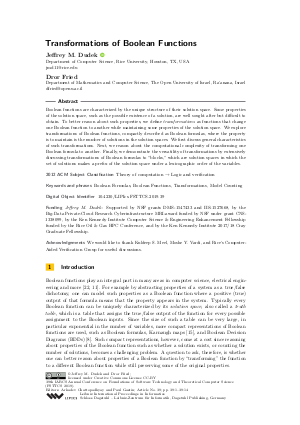@InProceedings{dudek_et_al:LIPIcs.FSTTCS.2019.39,
author = {Dudek, Jeffrey M. and Fried, Dror},
title = {{Transformations of Boolean Functions}},
booktitle = {39th IARCS Annual Conference on Foundations of Software Technology and Theoretical Computer Science (FSTTCS 2019)},
pages = {39:1--39:14},
series = {Leibniz International Proceedings in Informatics (LIPIcs)},
ISBN = {978-3-95977-131-3},
ISSN = {1868-8969},
year = {2019},
volume = {150},
editor = {Chattopadhyay, Arkadev and Gastin, Paul},
publisher = {Schloss Dagstuhl -- Leibniz-Zentrum f{\"u}r Informatik},
address = {Dagstuhl, Germany},
URL = {https://drops.dagstuhl.de/entities/document/10.4230/LIPIcs.FSTTCS.2019.39},
URN = {urn:nbn:de:0030-drops-116019},
doi = {10.4230/LIPIcs.FSTTCS.2019.39},
annote = {Keywords: Boolean Formulas, Boolean Functions, Transformations, Model Counting}
}

 Creative Commons Attribution 3.0 Unported license
Creative Commons Attribution 3.0 Unported license




















